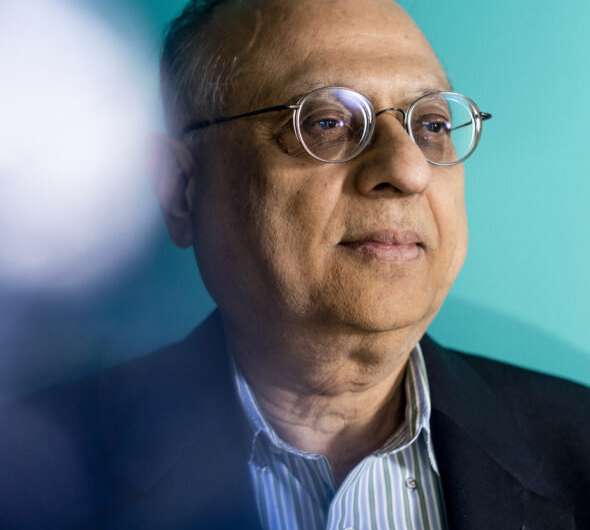
There are many mysteries still to unravel in the world of quantum mechanics, but scientists at Northeastern believe they’ve made a “holy grail” discovery that could help pave the way for the next generation of electronic devices.
Their findings, published recently in Nature, center mostly on the discovery of a so-called topological axion insulator, a unique state of quantum matter of which researchers previously only theorized existed, according to physicist Arun Bansil, who led a team of researchers at Northeastern involved in the study. There were several dozen scientists from universities around the world involved in the project.
This axion insulating state was realized, Bansil says, by combining certain metals and observing their magnetoelectric response. In this case, researchers used a solid state chip composed of manganese bismuth telluride, which were adhered together in two-dimensional layers, to measure the resulting electric and magnetic properties.
Researchers note that such a finding has implications for a range of technologies, including sensors, switches, computers, and memory storage devices, among many others. The “storage, transportation, and manipulation of magnetic data could become much faster, more robust, and energy-efficient” if scientists can integrate these new topological materials into future devices, the researchers write.
“It’s like discovering a new element,” Bansil says. “And we know there’s going to be all sorts of interesting applications for this.”
Bansil says they selected this specific combination of material, which researchers constructed atom-by-atom in a small crystalline structure, because its surface conducts electricity, while the overall structure is largely non-conductive, or insulating—an unusual property that is produced by the strong magnetoelectric coupling of the layers.
In other words, topological insulators can be both conductors and insulators at the same time.
“The topological axion insulator has a miraculous ability that allows it to have very robust metallic or conducting electrons on its surface, even though the bulk of the material is insulating,” Bansil says. “It had only been predicted theoretically—now it’s been realized experimentally.”
An emerging class of electronic devices—so-called spintronics—relies upon this manipulation of quantum structure through something called electron “spin.” Spin, also called angular momentum, describes a fundamental property of electrons defined in one of two potential states: up or down, Bansil says. The way the electrons spin influence the direction of the magnetic field at work in any solid.
Whereas traditional electronics depend on batteries that store energy in the form of chemical energy, spintronic devices could harness magnetic energy from special kinds of materials—such as the manganese bismuth telluride chip used in the study—without the chemical reaction, making it much more efficient “candidate material” for future technology, Bansil says.
Spin batteries of this kind are still largely under development, but scientists believe topological insulators could be the key to unlocking such technology, Bansil says. Researchers have proposed spintronics as the way to solve a number of problems with today’s electronics, including issues of power consumption and operational speed in computers and other devices that rely on charge, he says.
“There is no question the next generation of electronics will need to have low-power consumption,” Bansil says. “When you discover new materials like this, that opens up the possibilities. These newer kinds of materials can help usher in entirely new technologies.”
Anyuan Gao et al, Layer Hall effect in a 2D topological axion antiferromagnet, Nature (2021). DOI: 10.1038/s41586-021-03679-w
Citation:
‘Holy grail discovery’ in solid-state physics could usher in new technologies (2021, August 10)
retrieved 10 August 2021
from https://techxplore.com/news/2021-08-holy-grail-discovery-solid-state-physics.html
This document is subject to copyright. Apart from any fair dealing for the purpose of private study or research, no
part may be reproduced without the written permission. The content is provided for information purposes only.
Stay connected with us on social media platform for instant update click here to join our Twitter, & Facebook
We are now on Telegram. Click here to join our channel (@TechiUpdate) and stay updated with the latest Technology headlines.
For all the latest Technology News Click Here
For the latest news and updates, follow us on Google News.
